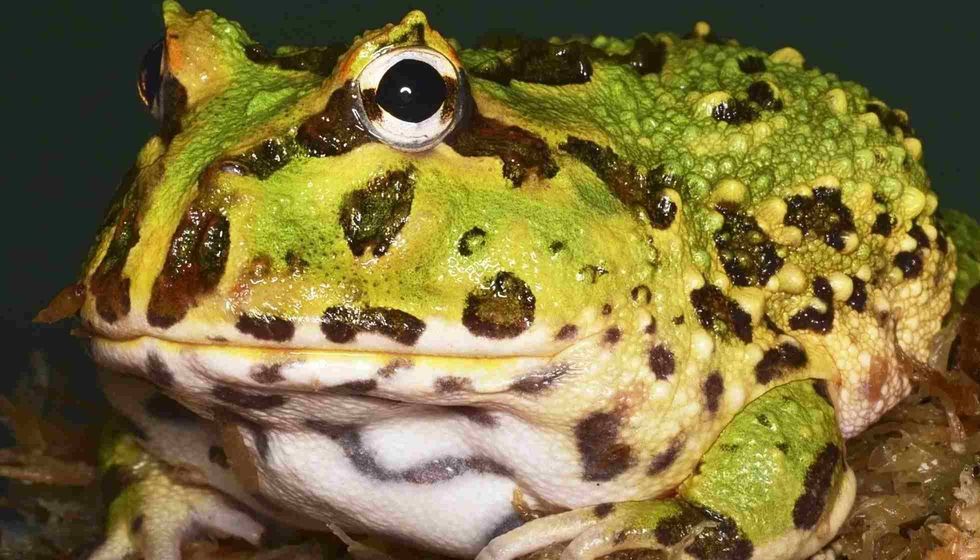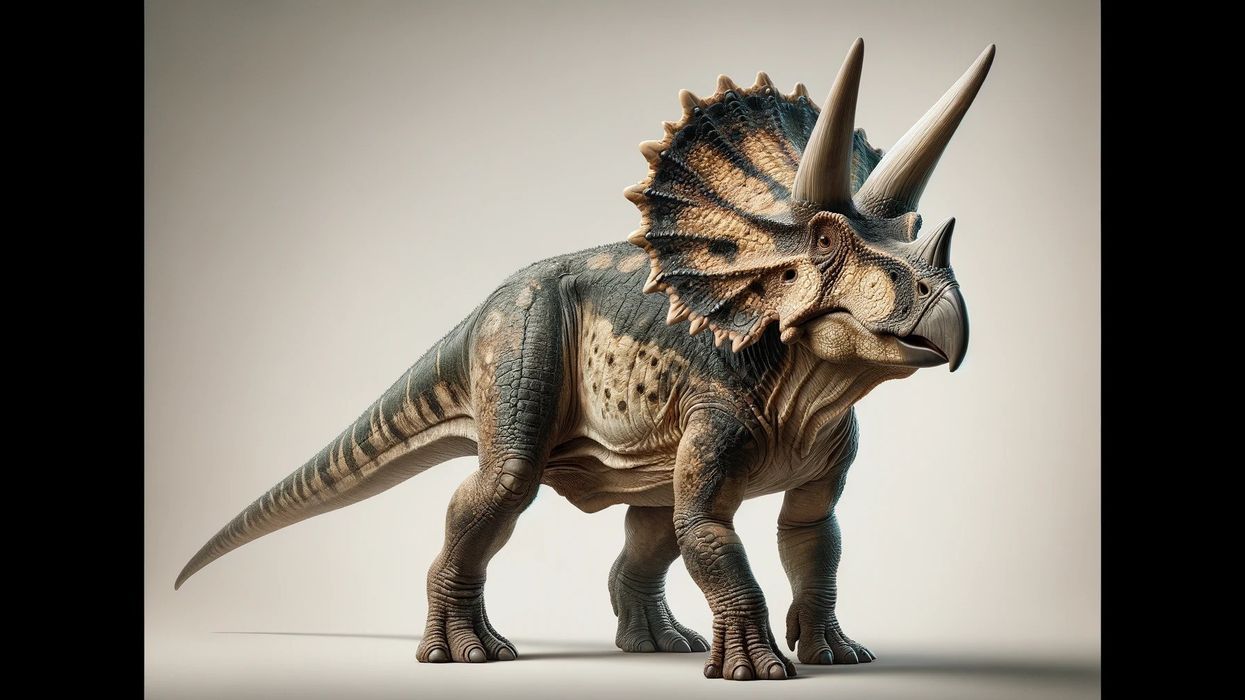The Ceratophryidae is the family of horned frogs and this family comprises 12 extant species and three genera which are distributed throughout South America. Horned frogs are a burrowing mammal species that have limbs that are adapted to plowing, their name refers to the appearance of a horned shape feature just above the eyes.
Another name for these species is based on the popular video game "Pac-Man Frogs".
The three genera of the Ceratophryidae family are Chacophrys, Ceratophrys, and Lepidobatrachus, which are further distributed into 12 different species.
Horned frogs hide in the leaves while exposing their eyes and wait for their intended meal to get close enough to strike and capture them. Ceratophrys fall prey easily to bacterial infections because of the humid environment and the thin skin that these animals have.
If you liked these true facts about Ceratophryidae, then you'll surely like these facts about Surinam toad and natterjack toad too!
Ceratophryidae Interesting Facts
What type of animal is a Ceratophryidae?
Not all ceratophryidae are horned frogs, but they have large mouths which are common with all the species which belong to this family. Earlier, these frogs were part of the Leptodactylidae family, and then later on they were divided into a smaller family of Ceratophryidae, order Anura and now also includes species from Telmatobiidae and Batrachylidae.
What class of animal does a Ceratophryidae belong to?
Ceratophryidae belongs to the Amphibian class, order Anura, they are cold-blooded, four limbs vertebrates. Amphibians mostly inhabit different habitats such as arboreal, fresh aquatic ecosystems, terrestrial, and subterranean. An amphibian is a creature that has the ability to breathe both on land and water.
How many Ceratophryidaes are there in the world?
Unfortunately, there is no accurate count on the population of Ceratophryidae.
As this family of frogs contains three extant genera which are further divided into 12 different species and are found all across Southern America in large numbers as well as in small groups, especially the ones that are near threatened on the IUCN Red List, it is impossible to know the exact populations.
Where does a Ceratophryidae live?
Ceratophryidae is native to the South American regions of Brazil, Uruguay, Argentina, Paraguay, and Bolivia. They are distributed in the open habitat and grasslands, near the flooded areas and ponds.
What is a Ceratophryidae's habitat?
Amazon horned frogs (ceratophrys cornuta) range in tropical open forest areas, under the leaves on the floor. They are terrestrial in nature and reside near the freshwater bodies and pools in the forest.
The genus Ceratophrys are terrestrial and non-aquatic creatures, they spend time near the tree roots, and branches to cover themselves with the leaves and wait to ambush their prey. These frogs will not hesitate to attack other frogs that come closer to their burrows.
Chacophrys prefer gallery forests and dry shrublands. The adults remain buried underground throughout the year but emerge during the heavy rains to breed in temporary water bodies.
Who does Ceratophryidae live with?
Ceratophryidae is a group of terrestrial frogs, they live their lives in solitary except during the breeding season when they come together for mating. These frogs are known for being fearless, they will try to defend themselves with their large vomerine teeth against all their predators.
How long does a Ceratophryidae live?
The average lifespan of Ceratophryidae frogs is six to seven years in the wild. In captivity, they can live up to 10 years if provided with proper care and diet.
How do they reproduce?
Ceratophryidae frogs mate seasonally, both the male and the female reach sexual maturity at the age of three years. These horned frogs mate in temporary pools and mating starts when the male calls to female and pairs with them. The average litter size of these horned frogs is about 300-600 eggs.
Ceratophryidae eggs are put on the back of the females by the males as it is the females' duty to provide a safe and appropriate place for their offspring to develop. After fertilization, tadpoles are hatched in 10-25 days.
What is their conservation status?
Most species from the family Ceratophryidae are listed as the Least Concern species on the IUCN Red List due to the vast population distribution but the Argentine horned frog (Ceratophrys ornata) is one of the species from the family that is listed as a near-threatened species on the IUCN Red List.
Ceratophryidae Fun Facts
What does Ceratophryidae look like?
The genus ceratophrys from the family Ceratophryidae, order Anura, are large-sized frogs, their body is round with dark green to tan lime in color.
The underside of these frogs is gray, with short and dark-colored limbs, their thighs are brown with vague yellow spots. Females are slightly larger than males as these frogs follow sexual dimorphism, their bodies exhibit small pointed swelling, and the mouth of a female is white and large, males have union pads on the toes of the feet.
The presence of horns above the eyes is the most distinguishing feature of this species.
Lepidobatrachus frogs are light olive green in color with light yellow or green spots on their dorsal. They have a circular, flattened body with eyes placed high on its head.
They are incompetent swimmers as they have short limbs, they do not have teeth, but they do have two sharp ridges, which is common to all Ceratophryidae, inside their mouth.

How cute are they?
On a scale of one to 10, the Ceratophryidae score 6 for their unique dorsal stripe, circular, and having circular bodies and a Pac-Man frogs appearance. If you are aware of the Pac-Man game series, then you will know that these frogs are similar in appearance with their circular body and big wide mouth.
How do they communicate?
Ceratophryidae recognizes their environment with the help of visual, tactile, auditory call, and chemical senses. Males are seen making a loud high pitched chirping call during the breeding seasons to attract females. These species use these high-pitched calls to indicate and forewarn their predators.
How big is a Ceratophryidae?
Ceratophryidae is large-sized frogs, an adult frog can grow up to 3-8 in (7.6-20.3 cm) in length similar to a large-sized tea saucer. They are almost as big as a common frog.
How fast can a Ceratophryidae move?
Unfortunately, the accurate speed of the Ceratophryidae has not yet been recorded, but naturally, these frogs are slow, they don't jump to move, they sit and wait for insects, flies, rodents, and small mammals to come to them.
How much does a Ceratophryidae weigh?
A fully grown male adult weighs between 14.1-16.9 oz (400-480 g) whereas females are slightly larger and heavier than males. Goliath frogs are way bigger than them.
What are the male and female names of the species?
No specific name has been given to either sex of the Ceratophryidae. Females have a dark-spotted belly, which makes it easier to determine their sexes.
What would you call a baby Ceratophryidae?
A baby Ceratophryidae is called a tadpole, like other baby toads from other species. The complete metamorphosis of the tadpoles happens in four to six weeks.
These tadpoles can produce distress calls from both underwater and outside the water, these species are the first that can communicate in their larval state.
Tadpoles are able to make these calls three days after hatching and can produce vocal sounds to communicate both in the water and out of the water. Once the eggs hatch, they survive on their own as neither parent takes part in feeding or providing shelter in their larval state.
What do they eat?
The feeding habit of these frogs makes them carnivorous, their animals prey on small reptiles, mammals, and other frogs. These frogs have been seen consuming large prey sometimes even the size of themselves.
These frogs are nocturnal in nature and when they hunt, they will sit and wait for their prey while mimicking the dried leaves around them. These species are carnivorous in nature mainly praying on small mammals, reptiles, and other frogs.
Argentine horned frogs (Ceratophrys ornata) are compulsive eaters, they will attempt to swallow almost anything that comes closer to their wide mouth.
Are they poisonous?
Yes, these frogs are poisonous as their blood contains toxic chemicals that are harmful to humans but they will not attack unless otherwise threatened.
Would they make a good pet?
Ceratophryidae makes the perfect pet choice for a beginner, unlike tree frogs. These animals can live comfortably in captivity and get settled into their aquariums. Pacman frogs do not enjoy being handled as they have extremely sensitive skin. These creatures are eye-catching and low maintenance, making them an easy pet to keep.
Though they can adapt easily to their surroundings, these species are aggressive in nature. A bite from the sharp teeth of these animals is painful and may draw blood, which means that they should not be handled and left alone and a bite from these sharp teeth will cause intense pain.
Lepidobatrachus frogs spend most of their time in the water with their eyes just above the water. Lepidobatrachus frogs are extremely rare to be found in a traditional pet shop.
To keep a pet lepidobatrachus, you will need to come close to their natural habitat by providing them with pine bark and damp soil in the enclosure.
Did you know...
Lepidobatrachus are extremely aggressive in nature and will puff up to appear large in size if they are threatened.
Chaco horned frogs are the single species of the genus Chacophrys belonging to the family of Ceratophryidae frogs.
As per the American museum of natural history, Beelzebufo from the family of Ceratophryidae were native to prehistoric South America millions of years ago.
Frogs drink water through the drinking patch, which is located on the underside of their belly and thighs allowing them to absorb water.
The eyes and nose of frogs are on the very top of their heads allowing them to breathe and see when their bodies are submerged under the water. While swallowing their prey, frogs blink and push their eyeballs down on the top of their mouth which helps them to push their prey down the throat.
Frogs shed their skin once a week. After it casts off the old skin, they usually eat it. They have marvelous night vision which is sensitive towards any movements allowing them to see in front, partially back, and sides.
How many types of Ceratophryidae are there?
Ceratophryidae is the family of frogs, with three extant genera which are further divided into 12 different species. The genus Ceratophrys consists of eight species whereas the Chavo horned frog is monotypic in the genus of Chacophrys, and the genus lepidobatrachus consists of other three species.
What is unique about the Ceratophryidae?
The Ceratophryidae has a unique feature of squirting blood from their eyes to use as a defensive mechanism towards their predators. From the corner of their eye ducts, they shoot blood that can travel up to 2-3 ft (0.6-0.9 m).
These creatures will shoot blood to confuse and stun their predators, their blood contains chemicals that are toxic to many canine species.
Here at Kidadl, we have carefully created lots of interesting family-friendly animal facts for everyone to discover! For more relatable content, check out these spring peeper facts and Spadefoot toad facts for kids.
You can even occupy yourself at home by coloring in one of our free printable Ceratophryidae coloring pages.









